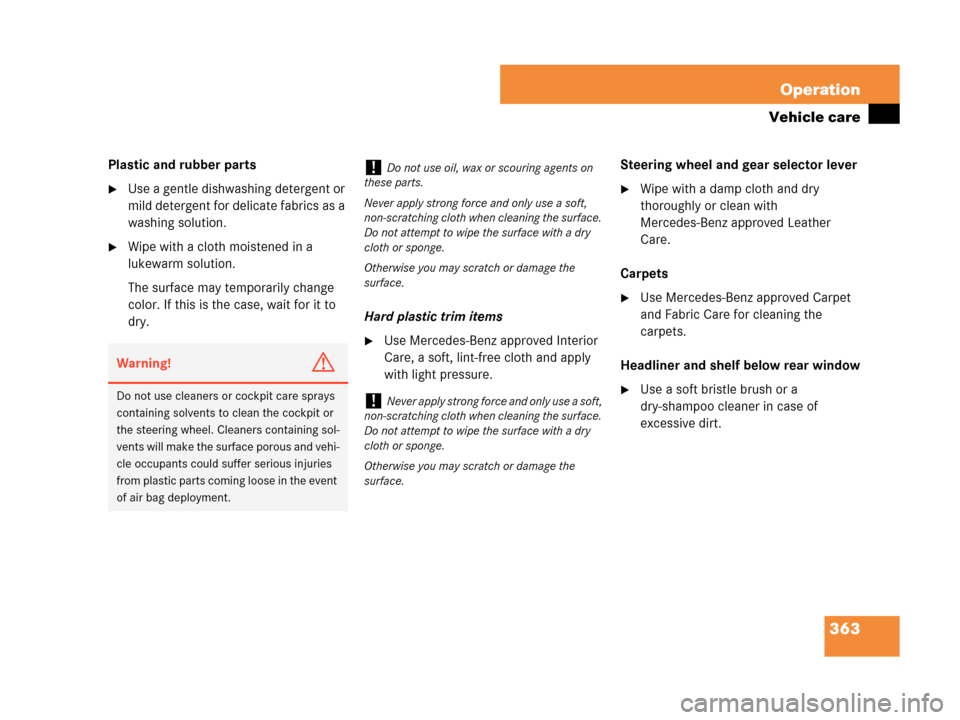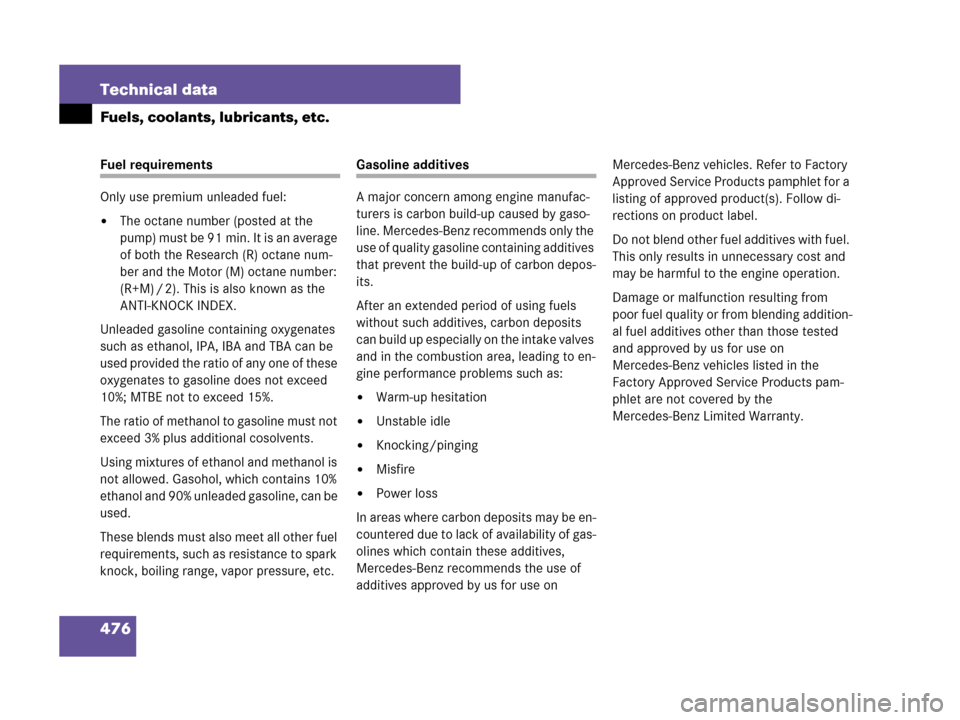Page 315 of 505

314 Operation
At the gas station
Check regularly and before a long trip
Engine compartment (CLK 550, example)
1Coolant level
2Brake fluid (fuse box cover removed)
3Windshield washer and headlamp
cleaning system*Coolant
For normal replenishing, use water (pota-
ble water quality). For more information,
see “Coolant” (
�page 320) and see “Fu-
els, coolants, lubricants, etc.”
(
�page 472).
Brake fluid
Removing fuse box cover (
�page 457).Windshield washer and headlamp
cleaning system*
For more information on filling up the
washer reservoir, see “Windshield washer
system and headlamp cleaning system*”
(
�page 322).
Engine oil level
For more information on engine oil, see
“Engine oil” (
�page 317).
Vehicle lighting
Check function and cleanliness. For more
information on replacing light bulbs, see
“Replacing bulbs” (
�page 427).
For more information, see “Exterior lamp
switch” (
�page 54).
Tire inflation pressure
For more information, see “Recommended
tire inflation pressure” (
�page 331).
iOpening the hood, see (�page 315).
!If you find that the brake fluid in the brake
fluid reservoir has fallen to the minimum mark or
below, have the brake system checked for brake
pad thickness and leaks immediately. Notify an
authorized Mercedes-Benz Center immediately.
Do not add brake fluid as this will not solve the
problem. For more information, see also “Practi-
cal hints” (
�page 368).
Page 364 of 505

363 Operation
Vehicle care
Plastic and rubber parts
�Use a gentle dishwashing detergent or
mild detergent for delicate fabrics as a
washing solution.
�Wipe with a cloth moistened in a
lukewarm solution.
The surface may temporarily change
color. If this is the case, wait for it to
dry.Hard plastic trim items
�Use Mercedes-Benz approved Interior
Care, a soft, lint-free cloth and apply
with light pressure.Steering wheel and gear selector lever
�Wipe with a damp cloth and dry
thoroughly or clean with
Mercedes-Benz approved Leather
Care.
Carpets
�Use Mercedes-Benz approved Carpet
and Fabric Care for cleaning the
carpets.
Headliner and shelf below rear window
�Use a soft bristle brush or a
dry-shampoo cleaner in case of
excessive dirt.
Warning!G
Do not use cleaners or cockpit care sprays
containing solvents to clean the cockpit or
the steering wheel. Cleaners containing sol-
vents will make the surface porous and vehi-
cle occupants could suffer serious injuries
from plastic parts coming loose in the event
of air bag deployment.
!Do not use oil, wax or scouring agents on
these parts.
Never apply strong force and only use a soft,
non-scratching cloth when cleaning the surface.
Do not attempt to wipe the surface with a dry
cloth or sponge.
Otherwise you may scratch or damage the
surface.
!Never apply strong force and only use a soft,
non-scratching cloth when cleaning the surface.
Do not attempt to wipe the surface with a dry
cloth or sponge.
Otherwise you may scratch or damage the
surface.
Page 477 of 505

476 Technical data
Fuels, coolants, lubricants, etc.
Fuel requirements
Only use premium unleaded fuel:
�The octane number (posted at the
pump) must be 91 min. It is an average
of both the Research (R) octane num-
ber and the Motor (M) octane number:
(R+M) / 2). This is also known as the
ANTI-KNOCK INDEX.
Unleaded gasoline containing oxygenates
such as ethanol, IPA, IBA and TBA can be
used provided the ratio of any one of these
oxygenates to gasoline does not exceed
10%; MTBE not to exceed 15%.
The ratio of methanol to gasoline must not
exceed 3% plus additional cosolvents.
Using mixtures of ethanol and methanol is
not allowed. Gasohol, which contains 10%
ethanol and 90% unleaded gasoline, can be
used.
These blends must also meet all other fuel
requirements, such as resistance to spark
knock, boiling range, vapor pressure, etc.
Gasoline additives
A major concern among engine manufac-
turers is carbon build-up caused by gaso-
line. Mercedes-Benz recommends only the
use of quality gasoline containing additives
that prevent the build-up of carbon depos-
its.
After an extended period of using fuels
without such additives, carbon deposits
can build up especially on the intake valves
and in the combustion area, leading to en-
gine performance problems such as:
�Warm-up hesitation
�Unstable idle
�Knocking/pinging
�Misfire
�Power loss
In areas where carbon deposits may be en-
countered due to lack of availability of gas-
olines which contain these additives,
Mercedes-Benz recommends the use of
additives approved by us for use on Mercedes-Benz vehicles. Refer to Factory
Approved Service Products pamphlet for a
listing of approved product(s). Follow di-
rections on product label.
Do not blend other fuel additives with fuel.
This only results in unnecessary cost and
may be harmful to the engine operation.
Damage or malfunction resulting from
poor fuel quality or from blending addition-
al fuel additives other than those tested
and approved by us for use on
Mercedes-Benz vehicles listed in the
Factory Approved Service Products pam-
phlet are not covered by the
Mercedes-Benz Limited Warranty.